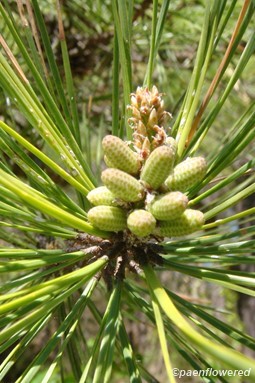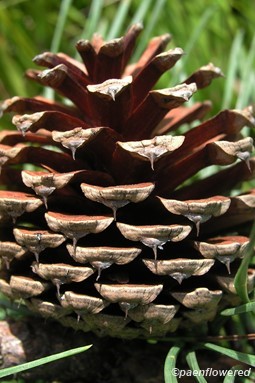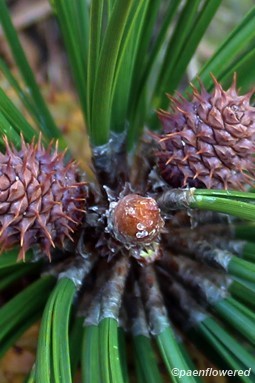Pinus rigida
Pinus rigida pitch pine
Like all pines, the pitch pine has needles in bundles, in this case in bundles of three. It is a medium-sized tree with needles 3 to 5 3⁄4 inches long. These needles are coarse, stiff and many of them are slightly twisted. They are 1⁄18 inch wide or more. The needle sheaths are relatively small - 1⁄8 to 5⁄8 inches long. The seed cones are stout and 1.5-3 inches long. They remain on the tree long after dropping their seeds. The cone scales are tipped with thorns up to 1⁄8 inch long. Pollen cones are smaller and are produced in clusters at the base of new twig growth.
The tree may grow to a height of 50-70 feet and have a trunk diameter of 1-2 feet. The only other eastern trees with needles in bundles of three are the swamp pine, the loblolly pine, and the longleaf pine. The latter two are southern species. The swamp pine has longer needles, no cone thorns, and longer needle sheaths. Only the pitch pine has a native range in Pennsylvania, though it is more common in the New Jersey Pine Barrens and in other Atlantic coastal regions.
The pitch pine is capable of surviving in a variety of soil types, including poor quality sandy or acidic conditions. It is also well adapted to wildfires as it has thick bark and is able to re-sprout shoots if the main trunk is damaged. Burnt trees often have stunted and twisted forms due to this re-sprouting. The pitch pine is not an important timber tree because of its often multiple and crooked trunks. It is also slow-growing for the first 5-10 years, then grows quite rapidly. In the past, it was a major source of pitch and the resin-rich and decay-resistant wood could be used for shipbuilding, railroad ties and mine timbers.
Habitat & Range
Frequent in barrens, and other sandy, sterile, acidic soils.
Present throughout the state.
| EMP: | FACU |
|---|---|
| NCNE: | FACU |
Phenology
Produces pollen mid April to May; evergreen
Characteristics
Tree medium-sized; single stright trunk (or multiple crooked trunks if resprouted) with many horizontal branches with large gaps; broad irregular crown
Needles in clusters of 3; stout, stiff, can be twisted; yellowish green color; 3-5 3⁄4 inches long
Twigs brittle, stout, yellow brown; buds egg-shaped, red-brown, about 0.5 inch long
Bark green & smooth when young, rough, gray brown and thick when mature; broad scales
Seed Cones egg-shaped, yellow brown, turning light brown when mature; single on brach, 1.5-3 inches long, almost stalkless; each scale is thin, flat, with a stiff, curved spine (prickle), many winged triangular seeds within; can remain on branch for 5 or more years; can remain unopened until heated by forest fire
Pollen Cones small, produced in clusters at the base of new twig growth
Height 50-70 feet; crown spread 30 to 50 feet
Fall Color evergreen
Age 100-150 yrs
Identification Tips
Seed cone scales have curved prickles
Plant Codes
S-rank: S5 (Secure)
G-rank: G5 (Secure)
Ecology
Seeds are an important food source for birds such as Black-capped chickadee, Pine warbler, Pine grosbeak and nuthatches. Deer and rabbits feed on the seedlings.


















Comments
Have you spotted this plant in your area? We'd love to hear about your experience! Share your comments or questions about the plant below. Comments are moderated before posting.